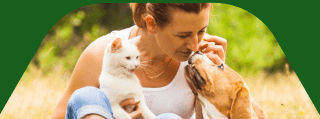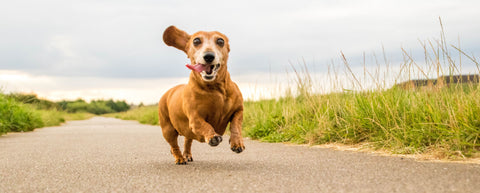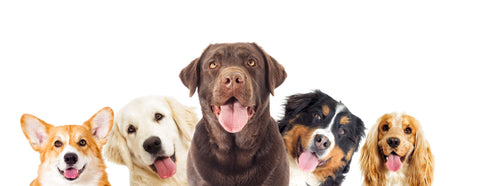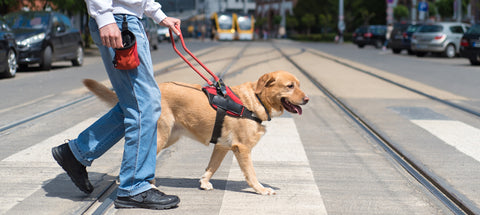As dog owners, we are not surprised that we’re often covered in an abundance of hair left from our pooches.
Shedding or molting is a natural process for dogs. For most, it is essential for the health of their fur and skin, ridding themselves of old hair by shedding it.
But is there anything that we as dog owners can do to save our sofa from disappearing under all that hair? We explore molting dogs and how much dog shedding is normal. Read on to find out more.
What is shedding in dogs??
Dog molting or shedding is a natural and an essential part of our dogs’ skin and fur health, even non-shedding dog breeds molt to a certain extent.
So, why do dogs shed? Looking back at our dog’s wilder cousins, as they lived outside, shedding allowed them to grow thicker winter coats, therefore helping them to survive the colder months, while a lighter coat in the summer months helped them to keep cool enough to hunt when temperatures increased. Although it can be a nuisance to owners, shedding fur is an important part of your pooch’s health.

How does dogs hair grow?
There are several phases of growth when dogs shed:
- Anagen – the active phase of growth where the hair continuously grows.
- Catagen – is the rest phase where the hair stops growing and may become detached from the hair follicle, this is where the hair will come out with brushing or if your dog brushed against your leg or sofa.
- Telogen – the hair falls out and makes way for a new phase of growth.

Does every breed of dog shed?
Whilst all dogs shed their fur, some shed less than others. Hair follicles on your dog will determine things like:
- Texture
- Length
- Rate of growth
- Shedding
Which dog breeds don't shed their fur?
So, we know that all dogs shed their hair at a varying degree; however, some dog breeds shed less. If you’re looking for a dog that doesn’t shed as badly, you can choose a lower allergen dog.
Pet or Dog dander is composed of microscopic flecks of skin shed by your pet. These bits of skin can cause reactions in people who are allergic to these triggers. Lower allergen dogs can produce less dander.
Because of this, lower allergen dogs can make a more suitable pet for people who have previously experienced allergies to pet fur and dander (which can be a bonus if you don’t like the mess of a dog that excessively sheds). Some lower allergen dog breeds include:
- Poodle (and some poodle cross’), probably the more recognizable of the lower allergen dogs. With more cross-breeding than ever, the poodle continues to make it into the American Kennel Club’s list of most popular breeds.
- Schnauzer, a loyal, intelligent, and very trainable companion. These dogs shed, but not in large amounts. For those with mild allergies, this can be minimized with regular grooming.
- Bichon Friese’s are a bundle of personality and charm, easily identifiable by their pure white coat. Great for little shedding, but remember to regularly brush and groom to avoid knots and matting.
- Bedlington Terrier, these guys have wonderfully curly coats which are the perfect mix of soft and harsh hairs but not wiry.
- Lagotto Romagnolo, aka the “Truffle Dog”. Known for being hard-working, strong, and having excellent noses, but who can ignore that cute teddy bear face? These guys have a thick, curly coat that sheds minimally, but they do need regular grooming.
It’s becoming increasingly popular for dog owners to seek dogs that are bred with a lower allergen breed such as cockerpoo’s (cocker spaniel and a poodle); however, there is no 100% guarantee that the lower allergen cross won’t shed – it is likely that it won’t shed as much.
Why is my dog shedding so much?
Different dog breeds shed different amounts. With dogs that shed more excessively, you’ll notice shedding more seasonally around spring or fall. So expect your dog to shed in March - June & September - November.
With others breeds you’ll notice molting all year round. A dog that has a thicker-double coat like a Golden Retriever will likely shed all year round.
The rate of your dog’s shedding or factors that trigger shedding can vary, including:
- Age
- Breed
- Health
- Environment
- Seasons
- Nutrition
- Stress
- Puppy coat
Fact: Your dog’s diet and food matter! Up to 30% of your dog’s daily protein requirement can be used for the renewal of skin and hair.
How to stop your dog from shedding
You can’t stop your dog from shedding, but there are some good habits and routines that you can get into the limit the effects of shedding.
Warning: This may turn your dog into a diva.
- Brush your pooch daily. This will allow you to perfectly lift your dog’s loose hair while minimizing any skin irritation.
- Consider using an undercoat rake to remove shedding fur and mats hidden underneath your dog’s coat. This one from Furminatior is a great tool to safely and effectively remove loose, dead undercoat hair as well as dirt.
- Every 6-10 weeks you should bathe your pooch. This will help to keep their coat clean, keep them smelling pleasant and help to remove dead hairs. Use a gentle dog shampoo.
- A poor diet for your dog can affect their hair growth and skin health. You should ensure your dog’s diet is balanced with the right amount of protein and fats that will help to promote skin and coat health.
- If you have some concerns regarding your dog’s coat or skin, then book a visit to the vet. They’ll be able to help you and advise on your dog’s health concerns, nutritional needs and explore any possible illness’ that is causing excessive shedding.
Whether they shed an abundance of hair or don’t shed at all, one thing we can all agree on is that we love our pooches unconditionally and wouldn’t have it any other way (although our sofa’s might).
Are you a seasoned pro in dealing with pet hair? A newbie that has some new tips or tricks? Send them in and let us know, they might even be featured on our Facebook and Instagram pages.










